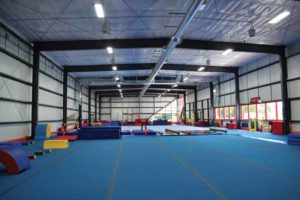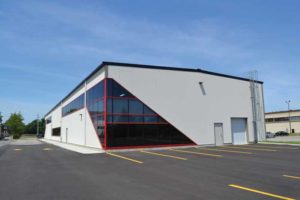Fit for a champion: Metal design elements help redesigned gym go for gold
By Rachel Mercado

Brantford Gymnastics Academy, located in Brantford, Ont., is a high-performance club and training gym where qualified coaching staff work closely with athletes to strive for improvement and excellence. The facility is fully outfitted with professional-grade equipment and has been home to more than 15 national medalists, eight national gold medalists, 93 provincial medalists, and 39 provincial champions over the past two decades.
In early November 2016, thick, dark smoke filled the air over the city’s north end as the academy was engulfed in flames from an electrical fire. The fire took more than three hours to control and completely destroyed all athletic equipment (including bars, mats, and vaults), as well as the entire building itself. It resulted in $1.2 million worth of damages.
The owners of Brantford Gymnastics Academy demonstrated unwavering commitment and dedication to their athletes by immediately taking action to secure temporary housing in a building owned and built by Lanca Contracting, a design-builder and general contractor (GC). The building, which was erected earlier in 2016, was the only facility in Brantford with the necessary area and clearance height for the gym’s programs. One week post-fire, BGA was open and operational.
In March 2017, the design-build contract for a new Brantford Gymnastics Academy facility was awarded to Lanca, and the company officially began construction in September of that year after receiving the necessary permits from the city. The Lanca team knew a custom-designed steel building would be the best option to meet insurance and safety requirements, given the material’s innate resistance to fire.
Moreover, a predesigned metal building was an excellent fit for the design-build method, given the ambitious timeline set forth by the owner. This is because with metal, sitework and other preparation measures happen concurrently as the structure is being manufactured to the owner’s precise specifications. Upon delivery to the jobsite, the building is ready for erection.

The design-builder was further able to design a building that delivered all the wants and needs of the Brantford Gymnastics Academy team while keeping the project within a predetermined budget. While a relatively simple program and quick completion time led to fewer labour hours (and thus less lost), the single-source nature of the metal building and associated components also reduced the chance for product inconsistencies and job delays, resulting in quicker project delivery and move-in for the owner.
Although none of the existing foundations were salvageable and new ones had to be put in place, the new facility was erected on the same location as the previous one, and the owner was firm on preserving the building’s width. The amount of floor space required for the academy is dictated by the gymnasium’s equipment and operational layout; any less would emanate a closed-off, crowded esthetic hindering gymnasts’ training and performance. Noting this as a priority, Lanca was able to maintain the existing width of the old structure while lengthening the building footprint. It designed the pre-engineered metal building system to the appropriate width, maintaining careful attention to the amount of interior floor space.
The owners and managers of the facility were instrumental in ensuring project delivery occurred on time and the owner/builder process was as smooth as possible. They took ownership of ensuring their operational needs fit within the physical parameters of the building and even included an engineer to lay out all the equipment needed for national-level training. Minor changes required throughout the building permit process had the team reconfiguring changerooms and observation spaces to ensure timelines were met.
The finished project is a testament to the resiliency and endurance of the building owners and facility managers in taking care of their portion of the construction in conjunction with their daily duties of running the temporary facility, training athletes, and overseeing competition schedules and needs.






